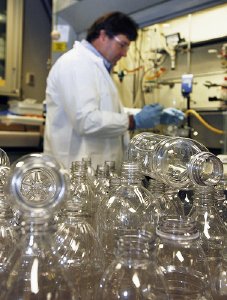Mar 15 2010
In a paper published in the American Chemical Society journal, Macromolecules, scientists from IBM (NYSE: IBM) and Stanford University detail discoveries that could lead to the development of new types of biodegradable, biocompatible plastics. The result of a multi-year research effort, the breakthrough also could lead to a new recycling process that has the potential to significantly increase the ability to recycle and reuse common PET and plant-based plastics in the future.

Today's announcement may have sustainability implications across a wide range of industries including biodegradable plastics, plastics recycling, healthcare and microelectronics.
IBM and Stanford scientists are pioneering the application of organocatalysis to green polymer chemistry, which represents a fundamental shift in the field. This discovery and new approach using organic catalysts could lead to well-defined, biodegradable molecules made from renewable resources in an environmentally responsible way.
"We're exploring new methods of applying technology and our expertise in materials science to create a sustainable, environmentally sound future," said Josephine Cheng, IBM Fellow and vice president, IBM Research - Almaden. "The development of new families of organic catalysts brings more versatility to green chemistry and opens the door for novel applications, such as making biodegradable plastics, improving the recycling process and drug delivery."
Disposable plastic bottles are among the most vexing environmental challenges. More than 13 billion plastic bottles are disposed of each year. While plastics are recyclable, the resulting materials are limited to "second generation reuse" only. This means the materials made from recycled plastic bottles are disposed in landfills. In the United States, up to 63 pounds of plastic packaging per-person is disposed of each year, instead of being repeatedly recycled. The IBM-Stanford breakthrough in green chemistry could lead to a new recycling process that reverses the polymerization process to regenerate monomers in their original state, reducing waste and pollution significantly.
IBM also is collaborating with scientists from King Abdulaziz City for Science and Technology (KACST) to develop the recycling process for polyethylene terephthalate (PET) plastics, which is a common plastic used in containers for food, beverages and other liquids.
These breakthroughs also hold promise for biomedical applications. For example, many effective drugs that are designed to target cancer cells are often so potent that they attack cancerous and healthy cells alike. The use of organocatalysis could help in the design of custom polymers that may aid in delivering drugs to a specific cell or region.
Scientific Details of the Paper
The paper, Organocatalysis: Opportunities and Challenges for Polymer Synthesis, outlines how and why organocatalysis provides new opportunities for the preparation of sustainable plastics. Through the introduction of organic catalysis to synthetic polymer chemistry, scientists have developed a broadly applicable technology with demonstrations in a diverse range of polymerization techniques and monomer types.
A major focus of their efforts has been on ring-opening polymerization, a strategy dominated by metal oxide or metal hydroxide catalysts. They have shown that organic catalysts both exhibit activities that rival the most active metal-based catalysts, and provide access to polymer architectures that are difficult to access by conventional approaches.
The paper outlines the development of several new families of highly active, environmentally benign organic catalysts for the conversion of renewable resources to products that exhibit cost/performance characteristics comparable to existing materials.
The paper also describes recycling or degradation strategies that would enable a "closed-loop" life cycle for materials that meet the needs of the marketplace while helping to minimize the environmental footprint left for future generations.
Additionally, the team has developed a new strategy for the synthesis of high molecular weight cyclic polyesters and the generation of new families of biocompatible polymers for biomedical applications.